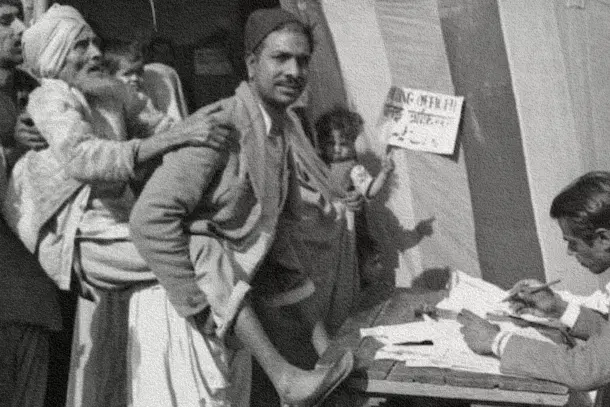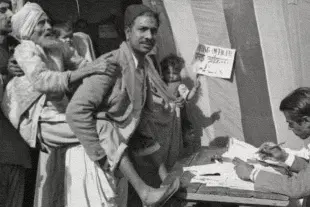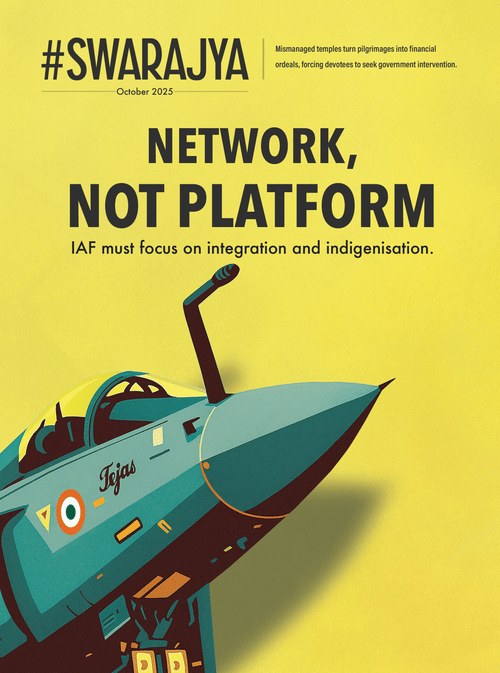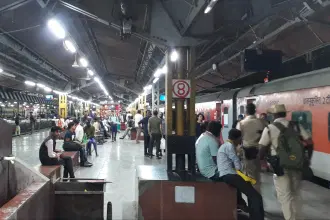Ideas
Why Lipset's Premature Democracy Still Haunts India... And What To Do Now?
Anmol N Jain
Sep 05, 2025, 03:53 PM | Updated Sep 08, 2025, 02:48 PM IST
Save & read from anywhere!
Bookmark stories for easy access on any device or the Swarajya app.


“Take my rights, give me 15k PCI.”
With this biting phrase, 'Goblipura Subbaramiah', in his essay Why India Needs a Sovereign Pivot: Dismantling Ajay Shah’s Delusions of Liberal Democracy, distilled the frustration of India’s middle class into a single line.
After seventy-five years of democracy, per capita income remains below $3,000. Rights and representation are abundant, but prosperity is not.
Subbaramiah’s polemic is more than provocation. It echoes a specific body of political science: Seymour Martin Lipset’s Modernisation Theory. In Political Man (1959), Lipset argued that democracy cannot simply be “planted” anywhere. It requires preconditions such as economic development, literacy, urbanisation, and a sizable middle class.
“The more well-to-do a nation,” he wrote, “the greater the chances that it will sustain democracy.”
India, by adopting universal suffrage in 1950 while still desperately poor and largely illiterate, inverted this sequence. The result has been predictable: weak state capacity, identity-driven politics, urban dysfunction, and appeasement that corrode governance.
The Modernisation Thesis
Lipset’s central insight was that democracy is not self-sustaining. It flourishes only when societies achieve a threshold of modernisation. Wealth, education, and social mobility are needed to create a broad base invested in stability. Without this, democratic politics risks devolving into populism and paralysis.
Samuel Huntington reinforced the point in Political Order in Changing Societies. He argued that premature democratisation produces disorder. Mass political participation without strong institutions leads to instability rather than liberty.
Subbaramiah channels this logic, whether deliberately or not. His description of universal suffrage as India’s “original sin” is a polemical echo of Lipset’s thesis. Democracy without preconditions is brittle and dysfunctional.
India’s Inversion
At the dawn of the modern Indian republic, it was among the poorest nations in the world. Literacy stood at roughly 18 per cent. Social hierarchies rooted in caste, village, and language dominated public life. Per capita income barely exceeded subsistence. By Lipset’s standards, none of the preconditions for a stable democracy existed.
Yet universal adult franchise was adopted overnight. Instead of nurturing a modern civic and civilisational identity, politics entrenched parochial loyalties. Caste blocs became vote banks. Linguistic and regional chauvinisms defined state politics. Mobilisation occurred around identities rather than developmental issues.
Economic choices compounded the problem. India granted political freedom, but economic life remained tightly restricted by the shackles of Nehruvian-socialism. Centralised planning and the licence-permit-quota raj curtailed individual enterprise, creating a paradox of political democracy without economic liberty. While the state was ineffective in enforcing the rule of law, it was heavy-handed in dispensing red tape, bureaucratic suffocation, and corruption.
This weakness of state capacity was visible in the rise of persistent internal conflicts. Naxalism, separatist insurgencies, and episodes of Islamic fundamentalism became recurring features of India’s political landscape.
Democracy, rather than absorbing and resolving these tensions, often amplifies them by providing space for such divisive appeals. What hard state capacity can do to solve such conflicts is for everyone to see with the 'Red Corridor' certain to become history in the coming months.
Another problem was that India’s democracy did not draw from its own civilisational traditions of pluralism and coexistence rooted in Dharma. Instead, it force-fitted borrowed ideas.
Secularism, imported in a European mould, was bound to be uneasy in a society where faith was organised differently, if we were to say it was. So, in practice, it slipped into pseudo-secularism. Rather than treating communities equally, it encouraged minority appeasement and neglect of Hindu concerns, breeding entitlement and resentment respectively, instead of fostering cohesion.
The elite strata, meanwhile, proved disconnected from the ground. India’s policymakers and opinion-makers were champagne socialists, not the champions of socialism, embracing lofty ideals while remaining blind to the lived realities of poverty, poor infrastructure, and social fragmentation. This disjointed elite consensus neither strengthened institutions nor mobilised society for modernisation.
Subbaramiah calls this a grotesque hybrid of mob rule and elite solipsism. More soberly, it was the inversion of modernisation theory’s sequence. Democracy emerged without the soil in which democracy grows.
Comparative Counterpoints: China and East Asia
East Asia offers the contrast. China pursued authoritarian modernisation through mass literacy drives, rapid industrialisation, and large-scale investment in infrastructure, without meaningful political liberalisation. Today, its per capita income is almost five times higher than India’s.
South Korea and Taiwan followed a similar sequence. Both remained authoritarian during their take-off years, focusing on economic growth and building state capacity. Only after reaching at least middle-income status did they transition to democracy: South Korea from 1987 and Taiwan beginning in the same year, consolidating in the 1990s.
Singapore presents yet another model. It operates as a dominant-party parliamentary system with constrained civil liberties, but it consistently ranks at the very top globally for government effectiveness, regulatory quality, and control of corruption. It combines limited political competition with first-world governance standards.
Subbaramiah’s admiration for China may be overstated, but it rests on real comparative patterns. Across the twentieth century, virtually no country moved from poverty to prosperity under full liberal democracy. Authoritarianism does not guarantee success, but sequencing matters. Modernisation first, democracy later.
India’s Present Predicament
India’s democratic record reveals the costs of ignoring this sequence. Despite its longevity, democracy has not delivered prosperity or civic order at scale.
Urban quality of life remains dismal. Cities are overcrowded, gridlocked, and poorly serviced. Infrastructure is reactive rather than anticipatory, a symptom of short-term electoral politics.
Civic sense is weak. Littering, encroachment, and indifference to public goods are widespread. Citizens enjoy rights but neglect responsibilities. Democracy has produced voters but not civic culture.
Much of this dysfunction stems from what Akshar Patel (aka The Emissary), in his recent piece (India's Political Samsara), called India’s “Three Thieves”: socialism, caste politics, and pseudo-secularism. To these, one must add a fourth thief that haunts India’s democracy: weak institutional capacity.
Socialism shackles enterprise and feeds the revdi culture, with schemes such as Ladli Behen channelling scarce resources into handouts rather than productive investment.
Caste and linguistic politics corrode cohesion and manifest in the clamour for a caste census, regional chauvinism, and slogans like jitni abadi, utna haq, designed more for electoral gain than genuine welfare.
Pseudo-secularism leads to appeasement, encouraging Islamic fundamentalism and selective exemptions that weaken state authority and deepen social polarisation.
Weak institutional capacity leaves the state stretched thin. The police-to-population ratio is only about 152 per 100,000, far below the UN norm of 222. The judiciary has just 21 judges per million citizens, compared to 150 in the United States and over 200 in parts of Europe. Diplomacy tells the same story: India has only around 4,800 diplomats, while the United States has more than 15,000.
For a country of over a billion people, these figures do not indicate “big government” but rather a dangerously understaffed one. What India calls bureaucracy is, in truth, a skeleton state stretched beyond its limits.
The fragility of institutions is evident when even the electoral process is not immune. Campaigns like #votechori and the slandering of electronic voting machines illustrate how the Election Commission can be maligned for petty political gain. The fact that such narratives find traction shows the irresponsibility of political actors and the vulnerability of institutions to manufactured suspicion.
Even amid this dysfunction, expectations are shifting. A burgeoning urban middle class, having less to worry about subsistence, is more focused on livability: cleaner cities, better infrastructure, reliable services.
In Maslow’s terms, India is moving up the ladder of needs. The very fact that these demands are now at the centre of political debate signals social mobility. The expectation now is a modern, functional state rather than mere survival.
Together, these dynamics produce a democracy in which every malcontent wields a veto, yet no one shoulders responsibility for collective outcomes. The result is stagnation: a political system heavy on performance but light on delivery.
As Subbaramiah’s own line put it: “Take my rights, give me 15k PCI.” It crystallises the exasperation of aspirational Indians who find a good, prosperous life elusive.
But the Way Forward Is Not Authoritarianism
India’s tragedy is not that it is a liberal democracy, but that it became one before it was ready. The choice to extend universal suffrage in 1950 was morally visionary but socially, politically, and economically reckless. It produced a sprawling democratic system without the social and institutional foundations that Modernisation Theory prescribes.
The comparison with East Asia underscores the point, but it should not be mistaken for an argument in favour of authoritarian rule. The lesson is about sequencing, not about abandoning liberty.
China, South Korea, Taiwan, and Singapore all built prosperity and state capacity before opening political systems more widely, and India inverted the order. The result has been weak governance, fractured politics, and a restless middle class.
The way forward is not authoritarianism but the completion of India’s unfinished modernisation within democracy. That requires neutralising the “Four Thieves”: redistributive socialism must give way to productive investment, shift from caste and linguistic parochialism to civic cohesion, from appeasement to equal enforcement of law, and from skeletal institutions to robust state capacity.
This does not mean copying China’s textbook authoritarianism. What India may require instead is the emergence of a Hard State within its democratic framework: one that is uncompromising in enforcing law and order, imparting justice, maintaining civic discipline, and safeguarding institutional integrity, while remaining open and flexible in economic life.
The urgency and frustration in Subbaramiah’s piece are not misplaced. And Lipset’s theory explains the cause. Democracy without development is democracy unmoored. India’s task is not to abandon democracy, but to give it the foundations that allow it to deliver.
Anmol N Jain is a writer and lawyer with a background in International Relations, Political Science, and Economics. He posts on X at @teanmol.





